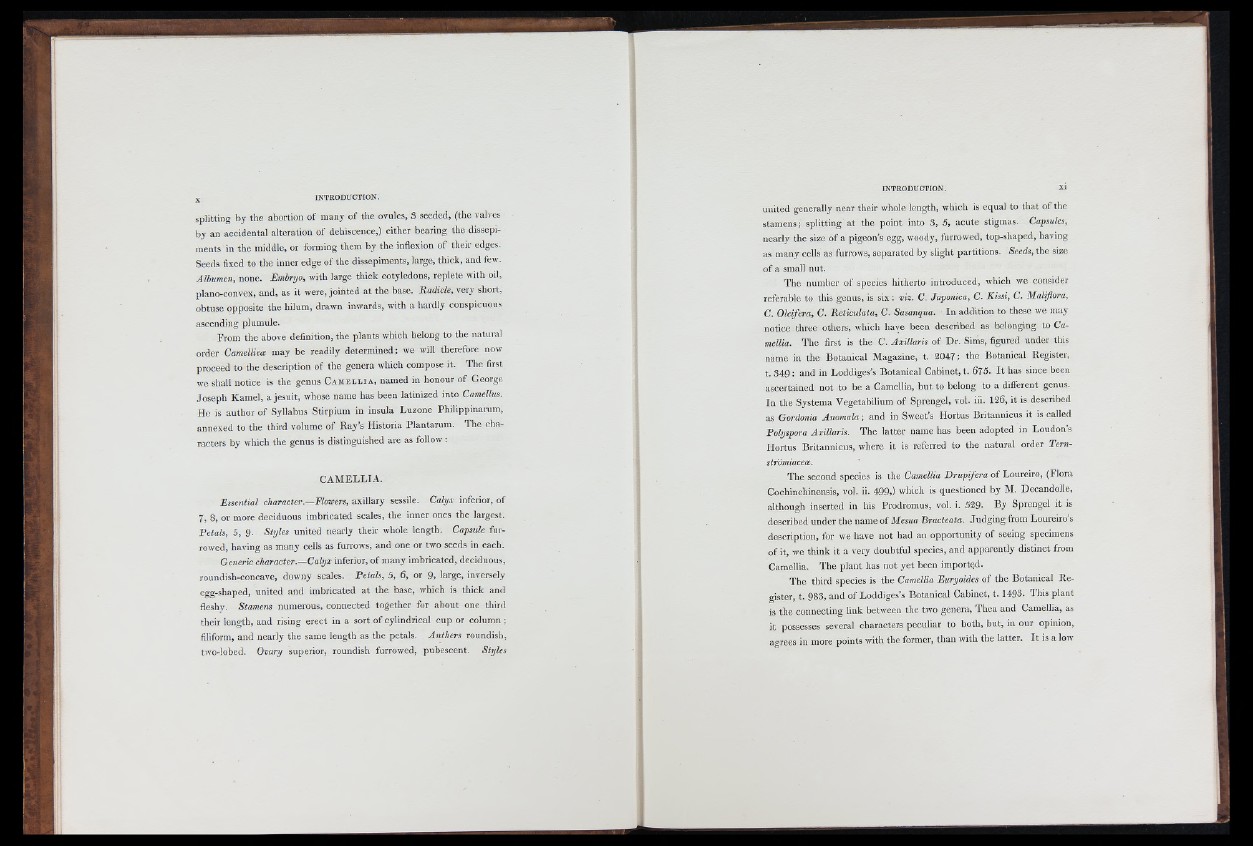
X INTEODUCTION.
splitting by th e abortion o f many o f the ovules, 3 seeded, (the valves
by an accidental alteration o f dehiscence,) either bearing the dissepiments
in the middle, or forming them by the inflexion o f their edges.
Seeds fixed to th e inner edge o f the dissepiments, large, thick, and few.
Albumen, none. Embryo, with large thick cotyledons, replete with oil,
plano-convex, and, as it were, jo in ted a t th e base. Radicle, very short,
obtuse opposite th e hiliim, drawn inwards, with a liardly conspicuous
ascending plumule.
From the above definition, th e plants which belong to th e natural
order Camelliece may be readily determined; we will therefore now
proceed to the description o f the genera which compose it. The first
we shall notice is the genus C a m e l l i a , named in honour o f George
Joseph Kamel, a je suit, whose name has been latinized into Camellas.
He is author o f Syllabus Stirpium in insula Luzone Philippinamm,
annexed to th e third volume o f R ay ’s Historia Plantarum. The characters
by which the genus is distinguished are as follow :
C AM E L L IA .
Essential character.— Flowers, axillary sessile. Calyx inferior, of
7, 8, or more deciduous imbricated scales, the inner ones the largest.
Petals, 0, 9. Styles united nearly their whole length. Capsule furrowed,
having as many cells as furrows, and one or two seeds in each.
Generic character.— Calyx inferior, o f many imbricated, deciduous,
roundish-concave, downy scales. Petals, S, 6, or 9, large, inversely
egg-shaped, united and imbricated a t th e base, which is thick and
fleshy. Stamens numerous, connected together for ab o u t one third
their length, and rising erec t in a sort o f cylindrical cu p or column ;
filiform, and nearly th e same length as the petals. Anthers roundish,
two-lobed. Ovary superior, roundish furrowed, pubescent. Styles
INTROCUCTION. XI
united generally near their whole length, which is equal to th a t of tlie
stamens; splitting a t the point into 3, 5, acute stigmas. Capsules,
nearly the size o f a pigeon’s egg, woody, furrowed, top-shaped, having
as many cells as furrows, sejiarated by slight partitions. Seeds, th e size
o f a small nut.
The number o f species hitherto introduced, whicli we consider
referable to this genus, is s ix ; viz. C. Japónica, C. Kissi, C. Maliflora,
C. Oleifera, C. Reticulata, C. Sasanqua. In addition to these we may
notice three others, which have been described as belonging to Camellia.
The first is the C. Axillaris o f Dr. Sims, figured under tliis
name in th e Botanical Magazine, t. 2047; the Botanical Register,
t. 3 4 9 ; and in Loddiges’s Botanical Cabinet, t. 675. I t has since been
ascertained not to be a Camellia, b u t to belong to a diflererit genus.
In the Systema Vegetabilium o f Sprengel, vol. iii. 126, it is described
as Gordonia Anómala; an d in Sweet’s Hortus Britanniens it is called
Polyspora Axillaris. Th e la tte r name has been adopted in Loudon’s
Hortus Britannicus, where it is referred to the natural order Tersi-
stromiacece.
The second species is the Came/Zia o f Loureiro, (Flora
Cochinchinensis, vol. ii. 499,) which is questioned by M. Decandolle,
although inserted in his Prodromus, vol. i. 529. By Sprengel it is
described under the name of Mesua Bracieata. Ju d g in g from Loureiro’s
description, for we have n o t had an opportunity of seeing specimens
of it, we think it a very doubtful species, and appa rently distinct from
Camellia. The plan t has not y et been imported.
The third species is the Camellia Etiryoides of th e Botanical Register,
t. 983, and o f Loddiges’s Botanical Cabinet, t. 1493. This p lan t
is the connecting link between the two genera, Thea and Camellia, as
it possesses several characters peculiar to both, but, in our opinion,
agrees in more points with the former, than with the latter. I t is a low